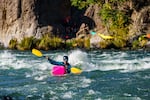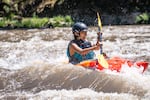
A Paddle Tribal Waters trainee prepares for the Klamath River descent by practicing on the Deschutes river in the fall of 2023.
Paddle Tribal Waters
On Thursday, a group of young kayakers from a variety of Indigenous tribes will embark on the first source-to-sea descent of the Klamath River since the country’s largest dam removal project was completed last fall.
An organization called Paddle Tribal Waters will lead the journey after years of intense training to prepare 43 Native American youth to kayak the entire length of the river — from the headwaters in Southern Oregon to the estuary in Northern California. The group aims to connect young people from rural and Indigenous communities to the rivers that support them.
“The dams are actually out,” said 15-year-old Tasia Linwood, an Indigenous kayaker who has been training for this descent for two-and-a-half years. “It’s one thing to hear that they’re removed, but it’s different when your hands are in the water. You can feel it in your heart and soul.”
Linwood, who has Karuk, Okanagan, Ojibwe, Wampanoag ancestry, said she’s trying to reassure herself as the launch date approaches.
“It feels more real when I understand that things can go wrong,” she said. “But I know I’ve got this. I know I’m safe.”

Indigenous kayaker Tasia Linwood practices whitewater skills on the Klamath River in June 2023.
Paul Wilson
Last fall marked the completion of the country’s largest dam removal project, which took out four of the six dams on the Klamath River. It was a monumental win for the Native American tribes along the river. The Indigenous communities of the Yurok, Karuk, Hoopa, Shasta and Klamath people were once thriving, connected to the river that fed them and functioned as transportation. The tribes spent decades fighting for dam removal to help the river and declining salmon populations.
Now, Copco 1 and 2, Iron Gate, and J.C Boyle dams have been removed, while the Keno and Link River dams on the upper river remain near the top of the watershed in Southern Oregon.
Nisha Supahan, a Karuk tribal member whose daughter Tasia Linwood is participating in the descent, said she is proud that her child will experience the river now that it is closer to the free-flowing waterway it used to be for their ancestors, and she’s impressed by the kayakers’ commitment to the river.
“Their fear, bravery, strength and joy get to be felt in the water that might have held the same for our ancestors,” she said.
The descent begins at the headwaters of the Klamath River in Southern Oregon between Crater Lake and Chiloquin. From there, they’ll paddle to Lake Euwana before exiting the water and portaging around the two remaining dams.
After 72 miles of paddling, they’ll reach the former J.C. Boyle Dam site in Southern Oregon. This marks the beginning of four days of technical whitewater, including a section with class 4 and 5 rapids that not all paddlers were cleared to attempt. The technical whitewater section concludes when they pass through the former Iron Gate Dam site near Hornbrook, Calif.
After more than 300 miles of paddling, their years of training will pay off with a one-of-a-kind dam-removal celebration near the mouth of the Klamath River, in the homelands of the Yurok Tribe in Northern California.
“Getting to watch these tribal youth grow as both kayakers and as people has definitely been one of the highlights of my life,” Paddle Tribal Waters co-founder Rush Sturges said. “They have essentially gone from complete beginners to some of them being grade 4, 5 kayakers.”
To these kayakers, the descent is about so much more than whitewater sports.
“Kayaking is a very cool part of this, but the first descent isn’t about the kayaks,” said 16-year-old Hoopa tribal member and Paddle Tribal Waters participant Julian Rogers. “It’s about the century-long battle that my people have been fighting and is the start of a new beginning.”
The Paddle Tribal Waters program was launched in 2022 by the advocacy groups Rios to Rivers and Maqlaqs Paddle. The program started with 15 Native students and grew to 43 by last summer. Leaders say the program offers a way to celebrate the Klamath dam removals and build a future of hope and healing.

Kayakers with Paddle Tribal Waters train for the first Klamath River descent since the removal of four dams.
Paddle Tribal Waters
Rios to Rivers has four programs around the world: Paddle Tribal Waters, Amazonian Rivers Initiative in Bolivia, Kayakimün in Chile, and UnDam the UN. Many students with Paddle Tribal Waters had the opportunity to travel for a semester with World Class Kayak Academy. This took them to places like Chile for five months of training and to learn more about water advocacy for Mapuche-Pehuenche youth.
“What I have enjoyed the most from my experiences with Rios to Rivers has been the cultural exchanges, learning about other natives and how the issues that they deal with are similar,” said Hoopa tribal member and Paddle Tribal Waters participant ‘A:de’ts-Nikya:w Rogers.
“I am mostly looking forward to what comes next. I hope that we will be inspired by this descent to keep fighting for our homes.”
